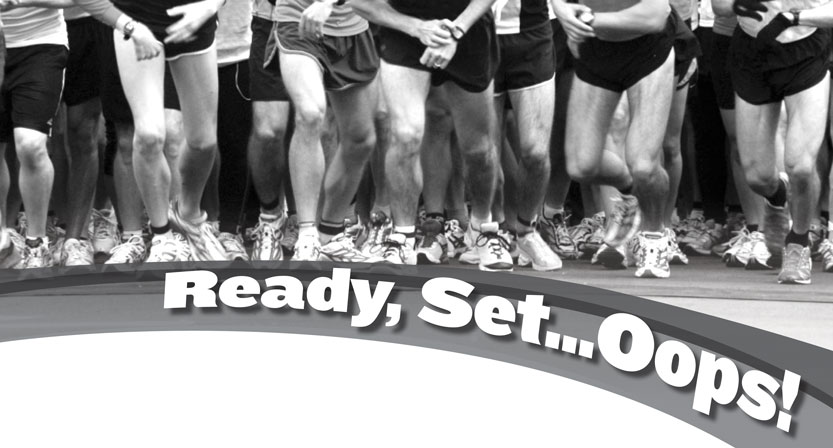
Top 5 Race-Day Mistakes
1. Going Out Too Fast
By far, this is the biggest mistake that runners make at road races, and uneven pacing leads to significantly slower finish times. Kids, military runners and “macho men” are the most frequent culprits, but all ages and both sexes too often sprint out at the start and lose momentum. If you routinely get passed by runners during a race, you’re undoubtedly going out way too fast. If you maintain your place in the pack, you’re still probably going out too fast. Only if you routinely pass runners throughout the event are you likely running the correct pace. And that’s a much nicer way to run, giving you a psychological boost.
The best way to ensure optimum pacing is to wear a runner’s watch at races, one that records your mile splits and allows you to analyze your results after the race. Even pacing is always best, keeping your fastest and slowest miles within five or 10 seconds of each other, assuming the wind or hills on the course don’t vary too much. For example, in a 5K two runners of the same ability could finish a full minute apart due to their different pacing. Runner “A” goes out too fast, recording mile splits of 8:00, 9:00 and 9:30, on his way to a 27:30 finishing time. Runner “B” practices even pacing, and does three consecutive 8:30 miles. “Runner B” is 30 seconds behind “Runner A” after the first mile, catches up at the two-mile mark, then surges ahead to a 26:30 final time, feeling refreshed.
2. Not Enough Warm-Up
The second most common racing mistake for most runners is inadequate warm-up, leading to tight muscles, possible injury and slower times. Even beginner runners should run at least a mile before a 5K race. Experienced runners routinely run two to three miles warm-up or more in preparation. A good rule of thumb is to warm up for the same number of miles (or minutes) it takes you to starting feeling loose and comfortable during your regular workouts. A proper race warm-up includes jogging slowly to start, various loosening up exercises (but not hard stretching), steadily increasing the pace, then a few “striders” (not a sprint, but an increased tempo over 30-100 yards, to transition from warm-up pace to race pace) five minutes before the start. In general, the longer the race, the less warm-up one needs, as the opening mile or two of a half marathon or marathon, run at slightly slower pace, can serve as part of the race warm-up, while letting the pack thin out.
3. Wearing the Wrong Amount of Clothing
Runners often either wear too much during the race, or too little before the race. Once thoroughly warmed up, runners should jettison their layers of clothing before heading to the starting line. I find that down to temperatures in the low to mid-40s, shorts and a racing singlet is sufficient. Only when the racing temperature is in the 30s will I consider either a T-shirt style or long-sleeve dri-fit shirt or track pants. Many runners wear too many layers of clothes in races (in part due to inadequate warm-up before the start), then overheat during the race, sweating uncomfortably. In contrast, other runners wear too little during their warm-up before the event, showing up in shorts and a T-shirt when temperatures are in the 40s or 50s. Whenever the temperature is in the 60s or below, your warm-up should include wearing sweatpants to start, and multiple layers on top, removing them while warming up.
4. Eating Too Much Before and Drinking Too Much During
Both can lead to stomach distress or cramping. Within two hours of a race start, I never eat any solid food, preferring only diluted fruit juice for energy and hydration. If three hours or more, then easily digested food like bananas, apples or oranges, or perhaps a bagel, are better than high-protein or high-fat food that sits in your stomach. Avoid drinking water or other beverages during shorter running events (5K to 10K), especially if you’re racing fast, as it’s hard to assimilate the water while running. Stopping for water or walking with cup in hand slows your time. Hydrate thoroughly before, then save the re-hydration for after the race.
5. Making Mistakes with Your Race Bib Number
These types of mistakes—whether wearing your number on your back, removing the pull tag before the race, covering up the number with clothing or accidentally attaching the safety pin to the pull tag—are more frequent with novice runners, but all levels make these mistakes that create major problems for race personnel, backing up the finishing chute. Your race bib number must always be worn on the front, and must be visible while approaching the finish line (not hidden under layers of clothing, or flipped up). Never remove the pull tag portion of the race bib number until after you cross the finish line, and never safety-pin that bottom-hole, pull-tag portion of the race bib number (otherwise your shirt might be torn when the pull tag is removed). If you don’t have a race number, don’t become a “bandit” runner by crossing the finish line. Also, if you’ve already finished the race, never cross the finish line a second time.

